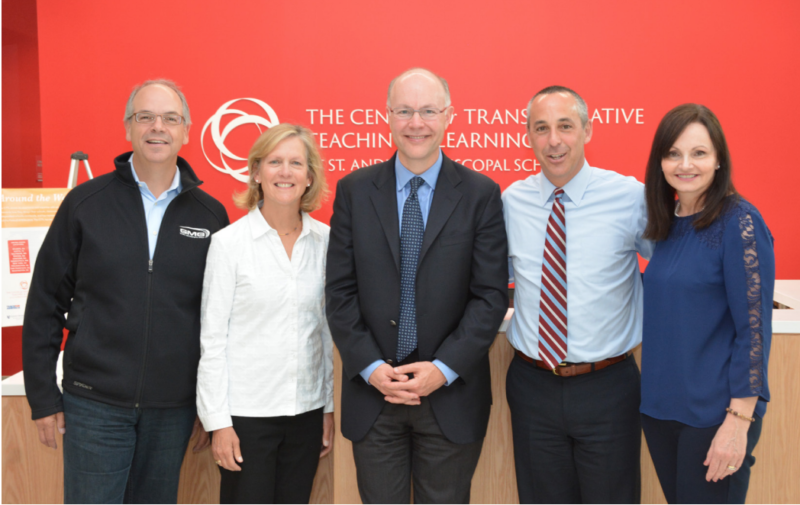With St. Andrew’s as the incubator, The CTTL innovates and inspires.
In the past 10 years, The Center for Transformative Teaching & Learning (The CTTL) has impacted tens of thousands of educators around the world – from presenting to, working with, and training more than 10,000 teachers and school leaders, to disseminating the insights of teacher-researchers through four volumes of its internationally recognized publication “Think Differently and Deeply,” to engaging thousands online through the self-paced Neuroteach Global suite of micro-courses.
This impact is beyond what Glenn Whitman, The CTTL’s Executive Director, and Dr. Ian Kelleher, Dreyfuss Chair of Research, could have imagined when they began teaching strategies informed by Mind, Brain, and Education Science (MBE) research. What they could fathom — and what they made a reality — is a future where 100% of St. Andrew’s preschool through Grade 12 teachers could provide their students with the highest quality MBE research-informed teaching possible.
“The school has been the incubator for every new innovation that has then been shared with the global community,” Whitman said. “The chief beneficiaries, at the end of the day, are St. Andrew’s students, and students around the world who have teachers who understand the research of how the brain learns, works, and thrives and can apply it to how they teach and how each of their students learn.”
Formalizing the Work
A handshake agreement between Whitman and Head of School Robert Kosasky led to the creation of The CTTL in 2011. The decision was both mission-driven, to fulfill the school’s promise to know and inspire each child, and sustainability-driven, to help distinguish the School amongst its peers in an economy transformed by the Great Recession.
“There was this really brave moment where we said, ‘The way we’re going to secure the School and, more importantly, benefit our students, is, we’re going to own great teaching, and we’re going to do it through our understanding and implementation of research,’” Kosasky said. “We knew what a yawning gap there was between what researchers knew and thought would work, and what teachers were actually testing in the field. We also knew this was a way to bring in great faculty and appeal to people who really cared about the quality of teaching, and associate them, in their minds, with St. Andrew’s.”
The School began to lay the groundwork to fulfill this vision in 2007, when, thanks to early intellectual and philanthropic support from Doug Smith and Gabriela Smith, Founder and Executive Director of Crimsonbridge Foundation, St. Andrew’s first trained its entire faculty in the Teaching All Kinds of Minds neurodevelopmental framework. This framework provided faculty with a common language for working with students through an MBE lens.
The shift from training St. Andrew’s teachers to empowering them to train other teachers was ushered in by partnerships with Crimsonbridge and other Washington, D.C. region foundations, such as CityBridge and the Marriott Family Foundation, who helped St. Andrew’s to cultivate relationships with local public schools and Teach For America (D.C. Region) corps members. In addition, the Omidyar Group played a critical role in funding early CTTL activities, such as “Think Differently and Deeply,” as well as the sustained training of St. Andrew’s faculty in MBE. These collaborations were key to The CTTL establishing an authentic public purpose, and for the Board of Trustees, led at the time by Anne Wallace, to see what a future Center could be for public, private, and charter school teachers and leaders.
“That’s when we realized we can leverage the internal talent and journey we were on to support St. Andrew’s teachers and educators around the world,” Whitman said.
When the Board of Trustees approved the creation of The CTTL, they gave Whitman four charges: The CTTL would make St. Andrew’s a laboratory for MBE research-informed teaching and learning excellence; it would lead and inspire research-informed practices and improved outcomes among a global network of like-minded schools; it would promote an institutional culture that attracts emotionally intelligent, highly motivated educators, and encourages faculty and student growth; and it would generate sustained philanthropic and programmatic revenue to support The CTTL’s current and future initiatives.
Ten years in, these core purposes hold true and continue to inspire The CTTL’s vision and mission.
Partnerships, Publications, and Possibilities
One of Whitman’s first tasks to build The CTTL was to start closing the “yawning gap” between researchers and teachers. Some of his first university connections would be The Center’s most significant: Dr. Mariale Hardiman of The Johns Hopkins University School of Education would help launch St. Andrew’s first research study in 2012, in which students in grades 2-8 contributed saliva samples and completed surveys to test the correlation between peer relationships, stress, and academic success.
In 2013, St. Andrew’s was the eighth school in the world to be invited to become part of the Research Schools International program, a collective of schools around the globe that conducts cutting-edge research, leads professional development, and disseminates research findings to the broader educational community alongside individual researchers at Harvard University’s Graduate School of Education (HGSE). Intellectual and philanthropic support from Meg Guerin-Calvert and Preston Calvert made this collaboration with Dr. Kurt Fisher and Dr. Christina Hinton of HGSE possible. It led to exciting opportunities for St. Andrew’s faculty and students, including a study published in 2015 that measured happiness, motivation, social relationships, and academic achievement among St. Andrew’s students in grades 4-12.
It was also critical early on to elevate the reputation of St. Andrew’s teachers as expert educators and teacher-researchers. The vehicle for this would be the first volume of “Think Differently and Deeply,” which was published in 2012 and featured articles by faculty, coaches, and alumni on how they had applied MBE to their classrooms, sports practices, and life after high school. Since that first volume, more 20,000 copies of the four volumes of “Think Differently and Deeply,” which expanded to include student and parent authors, have been shared with educators and policymakers around the world as a model for school or district-wide MBE translation and integration.
Whitman and Dr. Kelleher began to see a niche that The CTTL could fill – taking insights from MBE researchers and sharing them with preschool through Grade 12 teachers as “next-day strategies” and pathways for professional growth, what The CTTL calls “translation” work.
In 2015, The CTTL got the backing it needed to make it happen – a $250,000 EE Ford Educational Leadership Grant, which helped launch the first Science of Teaching and School Leadership Academy in 2017. Since then, through the annual summer Academies, The CTTL has supported nearly 1,000 teachers and school leaders who work with more than 60,000 students.
Also in 2017, The CTTL established its largest public school partnership to date, with Frederick County Public Schools in Maryland. Meg Lee, Director of the FCPS Department of Organizational Development, said the district’s partnership with The CTTL, which has included enabling staff to attend the Academy, read Neuroteach, and enroll in “Neuroteach Global,” has been key to developing their staff ’s expertise in evidence-based instructional practices, strategies, leadership skills, and professional learning.
“Mind, Brain, and Education Science is not an ‘initiative’ in our school district – it is the way we make research-informed decisions and progress on our systemic priorities,” Lee said. “Our partnership with The Center for Transformative Teaching & Learning has enhanced and accelerated our work in many ways over the last six years.”
In-person events were not the only tools The CTTL team leveraged to deliver translation work. Whitman and Dr. Kelleher co-authored “Neuroteach Global: Brain Science and The Future of Education,” published in 2016, inspiring schools across the country to begin their MBE journeys with a “Neuroteach” book study. And in 2018, the Chan Zuckerberg Initiative approved a grant to help fund a Neuroteach Global pilot program, which would lead to the development of 12 online micro-courses that cover learning environments, curriculum design, pedagogy and assessment, and student success and well-being. They would ultimately award The CTTL a $1 million grant to expand access to Neuroteach Global, joining the Omidyar Group in backing the project.
As the reach of the Center got bigger, the contributions of St. Andrew’s faculty deepened. St. Andrew’s teachers served as translation leaders at the Academy, guiding educators who teach the same subject or grade level on ways to apply the research to their classrooms. Leaders in Diversity, Equity and Belonging and Design Thinking at St. Andrew’s recognized the connection between MBE and those curricular and programmatic areas of the school. And, when learners who are enrolled in Neuroteach Global complete a microcourse assignment, called a “mission,” it is St. Andrew’s teachers who are assessing and grading them.
Impact at St. Andrew’s
To date, 40% of current St. Andrew’s faculty members have led workshops, authored articles, or actively contributed to The CTTL’s body of work. English and Psychology Teacher Andrew Seidman said his work with The CTTL – as a beneficiary of professional development, an author for “Think Differently and Deeply,” and a mission grader for Neuroteach Global – has made him a radically different educator from when he first began teaching.
“The CTTL hasn’t just helped me reconceptualize my curriculum, it’s allowed me to really deeply consider the goals that I have for my students and, perhaps even more importantly, the strategies that I use to help them reach those goals,” Seidman said.
Christine Lewis taught kindergarten through fourth grade before transitioning to her role as The CTTL’s Lower School Research Lead. In addition to translating research for elementary educators, Lewis and her Lower School colleagues led the research and design for the new “MBE Strategies Roadmap” for elementary educators, which provides teachers with easy access to MBE-informed research supporting well-being, achievement, pedagogy, literacy, and numeracy.
“The greatest benefit has been just the underlying affirmation, year after year, that educators are learning scientists,” Lewis said of being part of The CTTL’s work.
For students at St. Andrew’s, The CTTL has influenced the entire day-to-day school experience, from informing the daily class schedule and start and stop times, to reimagining final exams to include time for deep reflection and feedback, to creating opportunities for students to work directly with The Center as Finn Family Student Research Fellows or Academy Interns. Student Fellows have played an important role in affirming research-informed improvements at St. Andrew’s, including most recently the revised effort rubric.
What’s on the horizon for the next 10 years of The CTTL? The next frontier is creating resources designed for students. Neuroteach Global Student, set to launch next year, will help students build academic confidence, resilience, and performance by helping them learn how their own brains work and how to apply that knowledge to their own learning. The value of this initiative was affirmed by an additional EE Ford Educational Leadership Grant, making St. Andrew’s the first school to ever receive two such grants from the Foundation.
“One of the EE Ford Foundation goals in our Educational Leadership Grant Program is to help catalyze programs that we believe have the promise to expand far beyond the school seeking our support. This has clearly been the case with CTTL,” said John Gulla, the Foundation’s Executive Director.
At the end of the day, students have always been, and will continue to be, the “why” for St. Andrew’s commitment to professional development.
“We know our students better because of our training. We inspire our students better and we serve our teachers, and teachers around the world, better because of this work, because every day, in every classroom at St. Andrew’s and beyond, every student deserves a teacher who knows how their brain learns, works, and thrives” Whitman said.
This article was written by Kirsten Petersen and originally appeared in St. Andrew’s Episcopal School Magazine in recognition of the CTTL’s 10th anniversary.




